As the owner of a large breed dog, one of the most important things you can do for your pet is to provide them with a nutritious and balanced diet. Not only will this help to keep them healthy and happy, but it can also prevent a range of common health issues, such as obesity, dental problems, and digestive issues.
But with so many different types of dog food and feeding options available, it can be overwhelming to know what to choose. So, what is the best diet for large dogs?
The best diet for large dogs is one that is balanced and appropriate for their life stage and energy needs. This typically includes a combination of high-quality protein, healthy fats, vitamins, minerals, and fiber. Large breeds can also derive nutrients from grains, fruits, and vegetables for optimum health.
Okay, that’s the short answer.
With so many options available, it can be overwhelming to know what to feed your large breed puppy, whether you have a German Shepherd like me, a Poodle, Great Dane, Saint Bernard, Newfoundland, Great Pyrenees, or a Mastiff, to name but a few.
But don’t worry! In this ridiculously detailed guide, I’ll explain everything you need to know about the best diet for your large dog to ensure your doggo stays well-fed, fit, and healthy.
I’ll provide you with comprehensive info on large and giant breed dog nutrition, including tips on choosing the right food and meal plan for your furry friend.
You’ll also learn:
- Specific foods large breeds can and can’t eat
- Feeding schedules for large dogs
- Tips on feeding bones and treats for big dogs
- How to transition your large dog to a new diet
Let’s get started!
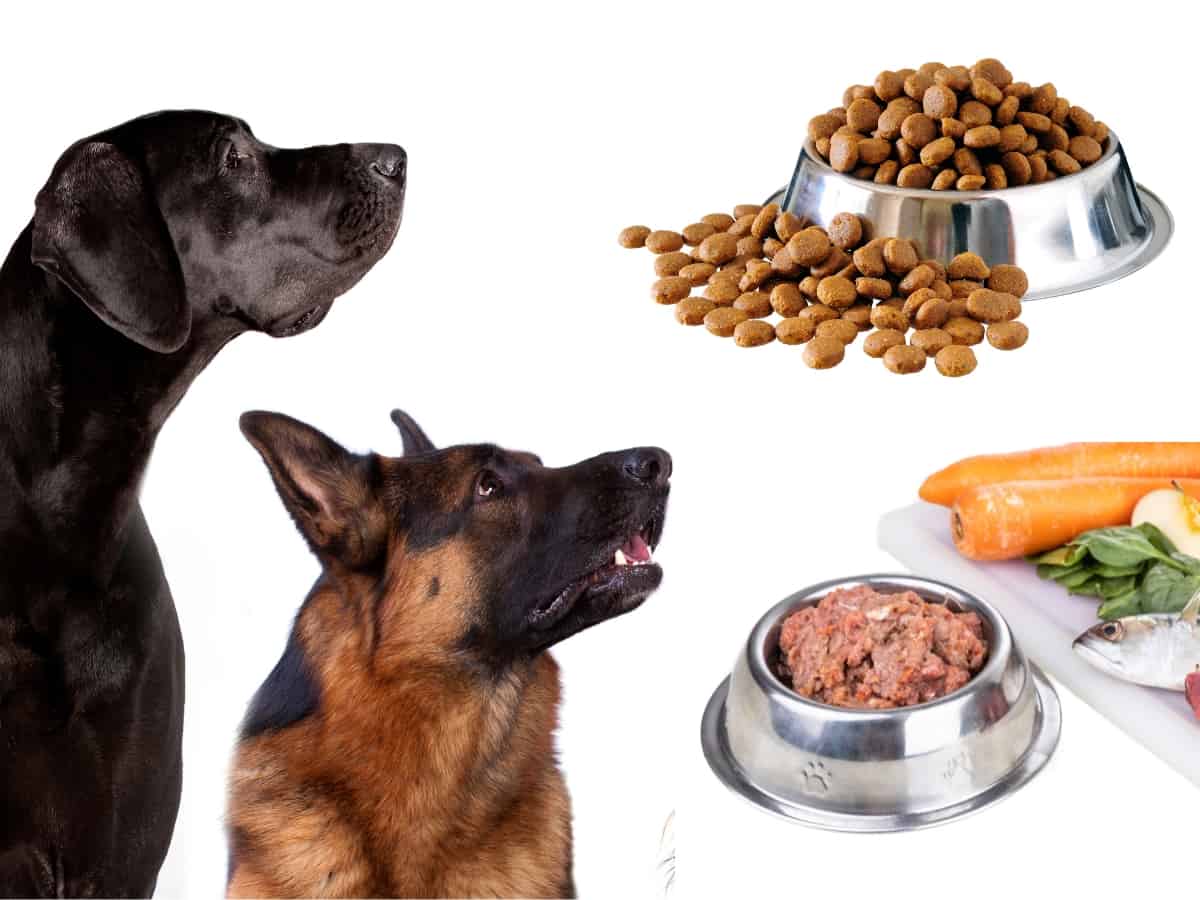
The Nutritional Needs of Large Dogs
The Association of American Feed Control Officials (AAFCO) defines large and giant breed puppies as those expected to weigh more than 70 lbs at their mature adult weight. However, I would say that 50 lbs is a better cut-off. So, what are the nutritional requirements of large dogs?
Large dogs require 22% protein during growth phases and a minimum of 18% protein as adults. Large breed puppies require 8% fat, while adults require 5%. Water, carbohydrates, vitamins, and minerals are also essential for survival.
Knowing the macronutrients your dog needs is crucial for keeping his essential body functions working perfectly and getting him food that can support his growth and help maintain good health.
Without the correct ratio of protein to fat or protein to carbs, your dog might become overweight or undernourished.
The MSD Vet Manual details the nutritional requirements of dogs, which describes all the essential nutrition required by our furry friends.
Let’s take a look at the different types of nutrients in the next section: protein, fat, carbohydrates, vitamins, minerals, and water.
Protein
When selecting what to feed your large breed dog, choose foods with high-quality animal-based protein sources, such as beef, chicken, turkey, lamb, pork, eggs, and fish, and plant-based proteins, such as grains, legumes, and vegetables.
Protein is the essential nutrient in your large dog’s diet and meal plan. It serves a variety of purposes:
- It gives your dog energy.
- Builds and repairs muscles.
- Forms new skin, hair, nails, and other tissue.
- Keeps the immune system healthy.
- Makes hormones, enzymes, and antibodies.
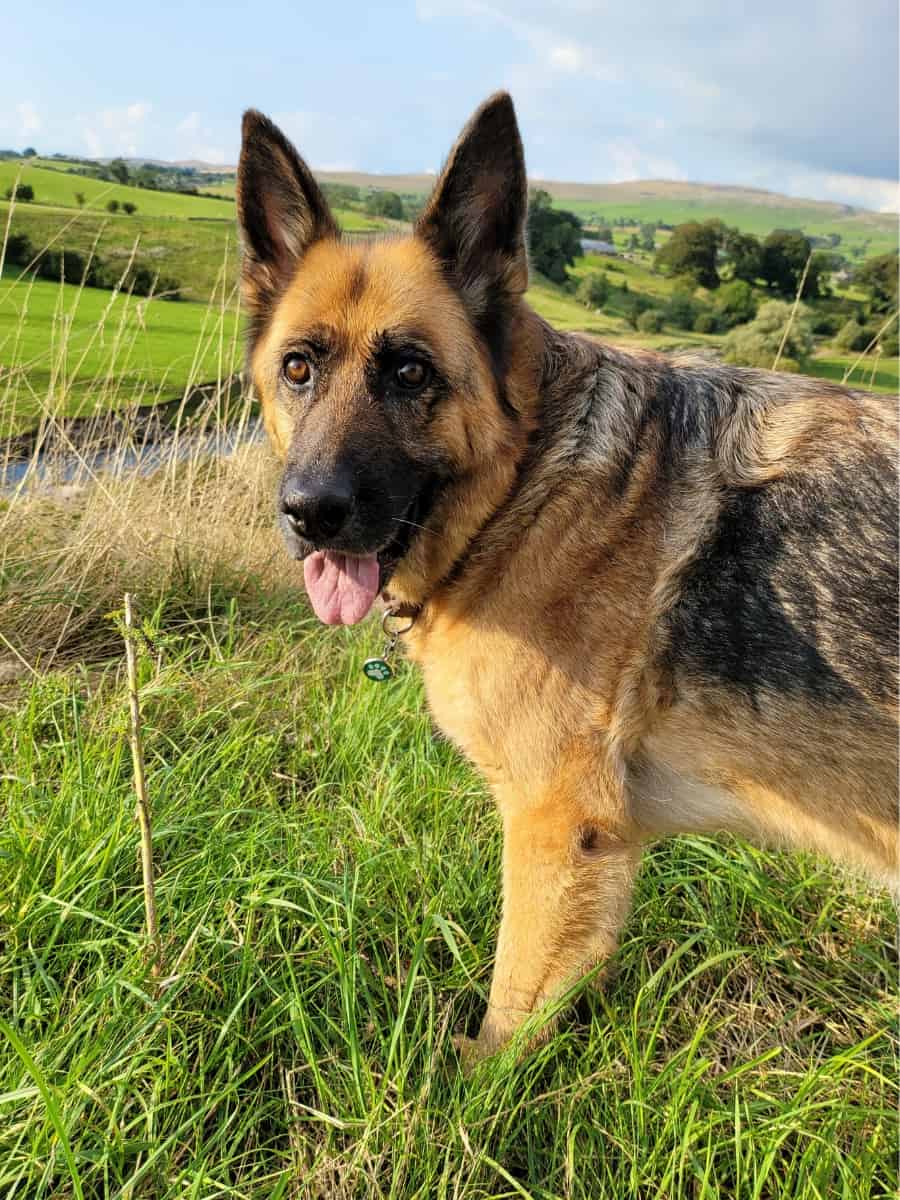
Fat
Fat is the second most important nutrient in a large dog’s diet. There are two types of “good fats” that are an important part of your dog’s diet – triglycerides and fatty acids.
- Triglyceridesserves serve as a source of energy, improve the taste and texture of your dog’s food, and aid in the absorption of fat-soluble vitamins.
- Fatty acids such as Omega-6, Omega-3, and DHA are vital for the development, structure, and function of body cells. They promote a healthy coat, skin, eyes, and nervous system and reduce inflammation.
Triglycerides are found in animal sources such as chicken and beef fat. Omega-3 fatty acids can be added to a diet through ingredients like fish oil and flaxseed oil, and Omega-6 fatty acids can be found in plant-based oils like corn oil, soybean oil, sunflower oil, and canola oil.
Carbohydrate
Though not considered essential nutrients for dogs, carbohydrates serve important functions in a dog’s body. Carbohydrates such as sugars, starches, and dietary fiber provide a highly digestible, easily accessible energy source.
These substances can be found in grains, legumes, and other plant-based ingredients, which are commonly used in commercial dog food. Some examples include oats, rye, peas, beans, corn, rice, barley, wheat, potato, sweet potato, and lentils.
Essentially, dogs as omnivores have evolved concerning their needs and carbohydrate tolerance in their diets.
Vitamins
Vitamins are necessary for a dog’s diet as deficiencies can cause various health issues.
- Vitamin A – A vitamin A deficiency can cause various symptoms in dogs, including impaired motor and vision function, skin lesions, respiratory issues, and a higher risk of infections.
- Vitamin E – Dogs not receiving enough vitamin E in their diet may exhibit signs of skeletal muscle breakdown, reproductive failure, and retinal degeneration.
- Thiamin – Thiamin deficiency can cause brain lesions and other neurological abnormalities if it occurs suddenly, and heart damage and death if it is chronic.
- Vitamin D – Some vitamins, such as vitamin D, play a significant role in extraskeletal health and are essential in small doses but can be toxic in high amounts.
Minerals
Twelve minerals are known to be essential for big dogs. Calcium and phosphorus are important for healthy bones and teeth, while magnesium, potassium, and sodium support nerve impulse transmission, muscle contraction, and cell signaling.
Some minerals, such as selenium and copper, are present in only small amounts in the body but play a role in various enzymatic reactions.
Large dogs can get too much or too little of a specific mineral in their diets.
For example, a calcium deficiency can cause secondary hyperparathyroidism, resulting in significant bone loss, skeletal abnormalities, and fractures. Canine diets rich in natural meat alone can cause a calcium deficiency.
Conversely, excess calcium can cause skeletal anomalies in growing puppies, especially those of large breeds, so large breeds should eat large-breed food. I cover this important topic later in the article.
Water
Water is essential for the proper functioning of a dog’s body. The benefits of water are:
- To regulate body temperature and maintain healthy organ function.
- Water is necessary for the digestion and absorption of nutrients.
- It helps to flush out toxins and waste products from the body.
- It prevents dehydration, which can lead to serious health problems, including kidney damage and heat stroke.
- Lubricates and cushions joints and helps movement.
In general, dogs should drink one ounce (30 ml) of water daily for each pound they weigh.
However, various factors can influence how much water your dog will drink, such as age, size, exercise level, diet (dry or wet dog food), weather, medication, and nursing mothers.
For example, puppies will generally consume more despite their smaller size.
Ensure your dog’s water bowl is always full – and you change the water frequently throughout the day. I like to change my German Shepherd’s water every 2-3 hours and more frequently in hot weather.
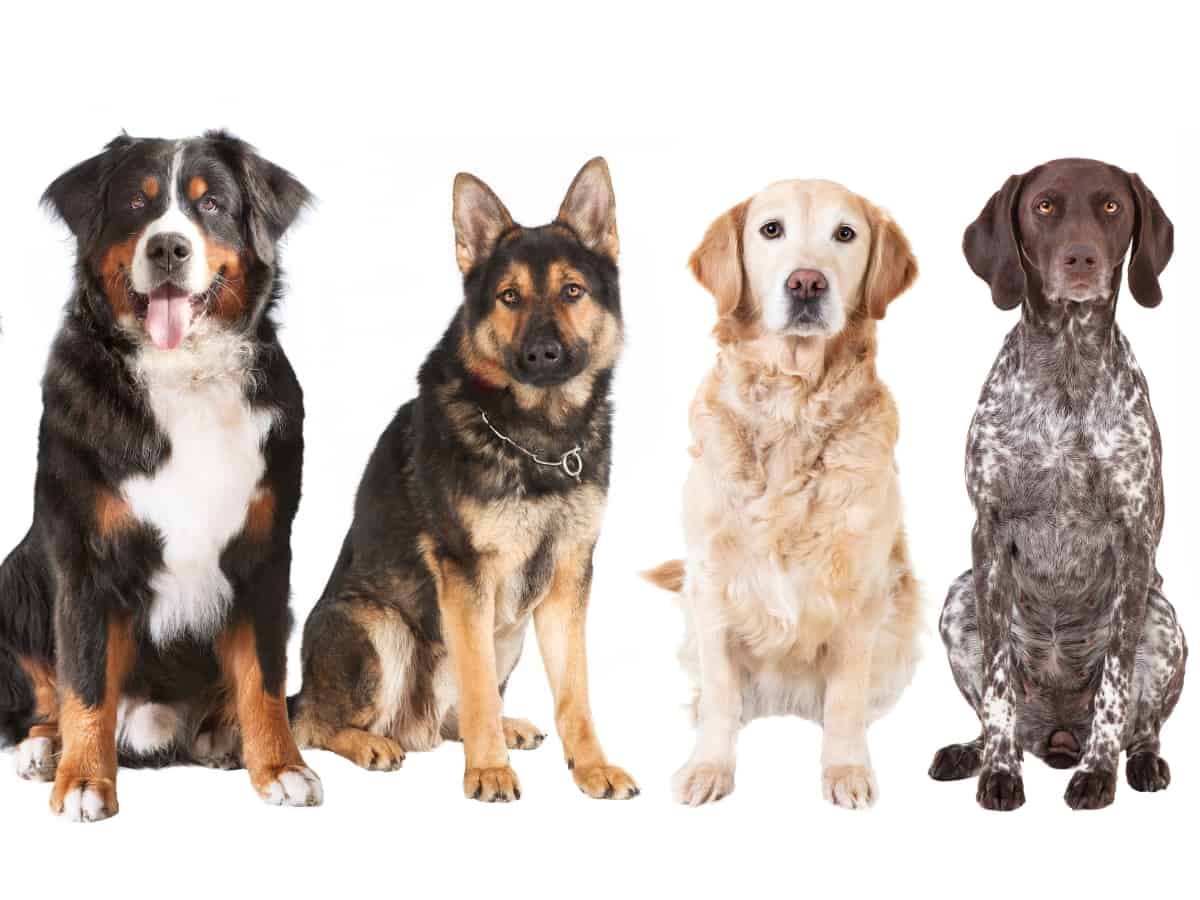
If you struggle to keep your doggo hydrated, here are some fun methods to ensure he gets enough water:
- Give your dog ice cubes.
- Add water to dry food.
- Feed fruits high in water content, e.g., watermelon or strawberries.
- Make doggie ice pops.
- Use a hose in warm weather to have some fun.
- Invest in a dog water fountain.
Nutrition According to Life Stage
What you feed your large breed also depends on age or life stage. Puppies, adults, and seniors all have different nutritional needs, as do pregnant and lactating dogs.
The AAFCO determines the minimum requirements for the nutritional adequacy of dog food. The documentation can be a bit of a heavy read, so here’s my simplified version:
| Life Stage | Protein (Minimum) | Fat (Minimum) |
|---|---|---|
| Gestation/Lactation | 22% | 8% |
| Growth (puppies) | 22% | 8% |
| Adult Maintenance | 18% | 5% |
| All Life Stages*** | 22% | 8% |
***A canine diet for “all life stages” simply means one that meets the nutritional requirements for any life stage, whether reproduction, growth, or adult.
Let’s sum it up!
Large breed puppies and pregnant or lactating females need a minimum of 22% protein and 8% fat, whereas adult dogs need a minimum of 18% protein and 5% fat.
When reading pet food labels, you must choose a diet according to your dog’s life stage. You can supplement your dog’s diet with multivitamins, joint support, and probiotics.
Pro tip! When feeding commercial dog food, the amount of protein is determined by analyzing the dry matter. This is the remaining amount after the moisture has been removed.
Nutrition According to Energy Needs
Your dog’s nutrition and subsequent energy needs will also vary according to size, activity level, and overall health. Energy is measured in calories and originates from the essential nutritional components of protein, fats, and carbohydrates.
Here are some examples:
- A lively and growing large breed puppy may need twice as many calories as an adult.
- A pregnant or lactating bitch will need significantly more calories.
- A senior dog may need 20% fewer calories in their diet.
- Some older dogs at risk of obesity may benefit from a diet with a higher protein-to-calorie ratio.
Always check with your vet first for the best way forward for your pet.
Do Large Breed Puppies Need Large Breed Food?
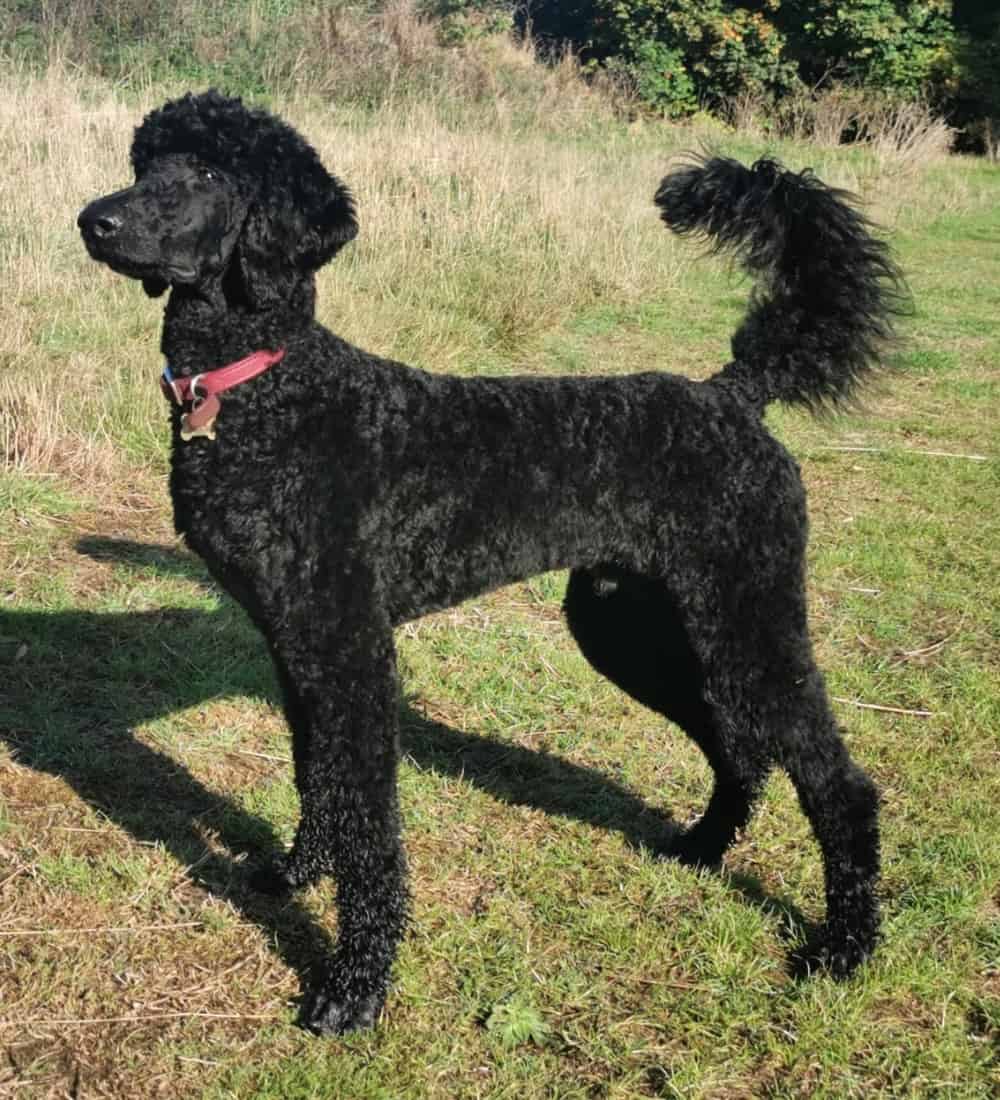
When it comes to the nutritional requirements of large breeds, there are significant food differences between young small dogs vs. large and giant breeds due to the growth rate of big dogs.
Standard Poodle pups grow much faster than Yorkshire Terriers – hence, they ought to eat different foods.
We know that large or giant dog breeds are more susceptible to developing skeletal problems during growth when they consume insufficient or excess nutrients.
Larger dogs are particularly predisposed to hip dysplasia and osteoarthritis, and two of the main culprits are excessive amounts of CALCIUM and rapid weight gain while their bones are growing.
Excess calcium during growth can increase the risk of joint issues in later life. Too much calcium can also cause deficiencies in other required nutrients, such as phosphorus, as these two nutrients work together to support the proper functioning of the body.
Puppy food for large breeds needs to have a carefully balanced calcium-to-phosphorus ratio to promote bone growth. You want enough to help their bones grow but not too much to cause overdevelopment.
In general, large and giant breed puppy foods should typically include high-quality protein, be low in fat, and have a good calcium content.
So, what about adults?
If you’re a regular reader of my blog, you’ll know I own a 90 lb (41kg) German Shepherd. I’m often asked by other owners whether their large dogs should have large-breed food. Here’s what I tell them:
Large-breed dog food is also important when your furry friend is an adult, as it will contain the proper balance of nutrients, much like puppy food, to ensure your dog stays in tip-top shape.
Remember, though, that you don’t need to switch to adult food until your dog is between 18 and 24 months old. This is because large breeds will continue to grow into their second year, and you do not want to switch too soon for optimal health.
What Foods Can Big Dogs Eat?
To select the best food items for your dog, whether feeding a homemade diet, a mixed diet, or giving treats, you need to know your options.
Large dogs can eat most protein, including lamb, beef, chicken, turkey, pork, fish, and eggs. They can also consume plant-based proteins/carbohydrates such as grains, legumes, and veggies. Bits of fruit, aside from grapes and raisins, are also nutritious.
I’ll review grapes and grape-adjacent products in this post’s “can’t eat” section. But first, let’s explore each food option your dog can eat in his diet.
Before I share a list of human foods that can be safely fed to dogs, it is important to consider the following:
- Remove the pits or seeds from fruits – They contain cyanide, which is toxic to dogs if ingested excessively.
- Cook most vegetables – To aid digestion and absorb all the nutrients, steam, bake, roast, grill, or mash dog-friendly vegetables.
- Don’t feed raw eggs and raw seafood – Avoid raw eggs and raw seafood due to the risk of salmonella and listeria.
- Know the risk of nuts – While some nuts can be consumed by dogs, they can cause digestive issues due to their high-fat content and are a choking hazard. Do not feed macadamia and black walnuts, as these are toxic to dogs.
- Dairy foods – Many dogs are lactose intolerant, which means they have difficulty digesting dairy foods, such as milk, yogurt, or cheese.
Large Dog Diet – Protein
Here is a tabled view of the main protein sources that dogs can eat.
| Lamb | Duck | Salmon |
| Chicken | Liver | Tuna |
| Turkey | Kidney | Mackeral |
| Beef | Heart | Oceanfish |
| Venison | Pork | Eggs |
Lamb
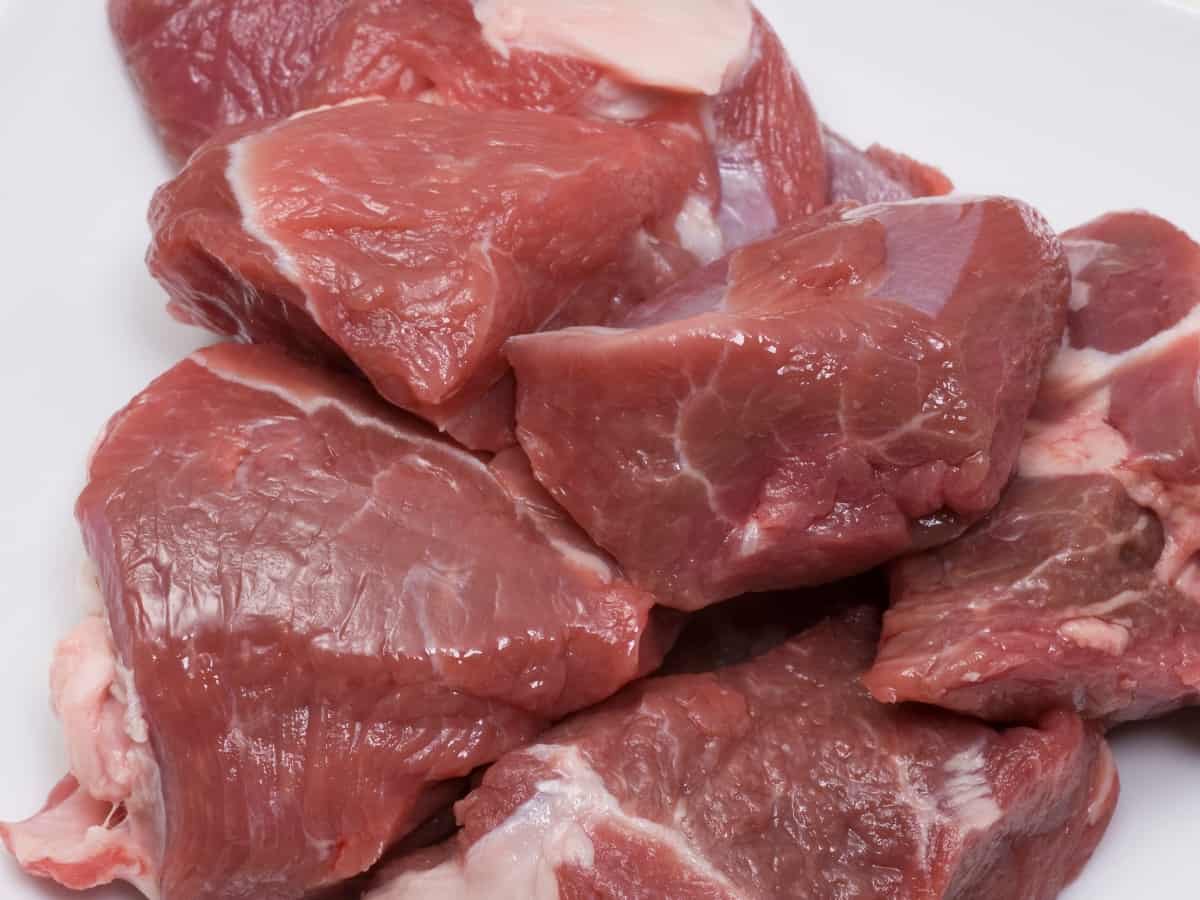
Lamb
Lamb is a holistic primary food source for a dog. It contains essential amino acids and dietary fat to sustain growth and energy and build healthy muscles, skin, and coats. It also contains vital vitamins and minerals and is easy for dogs to digest.
With a few fruit-driven carbs in your big dog’s diet, he can survive on an entirely raw and organic diet if your wallet can survive this feeding choice! You can, of course, choose to cook the meat if you prefer.
Beef
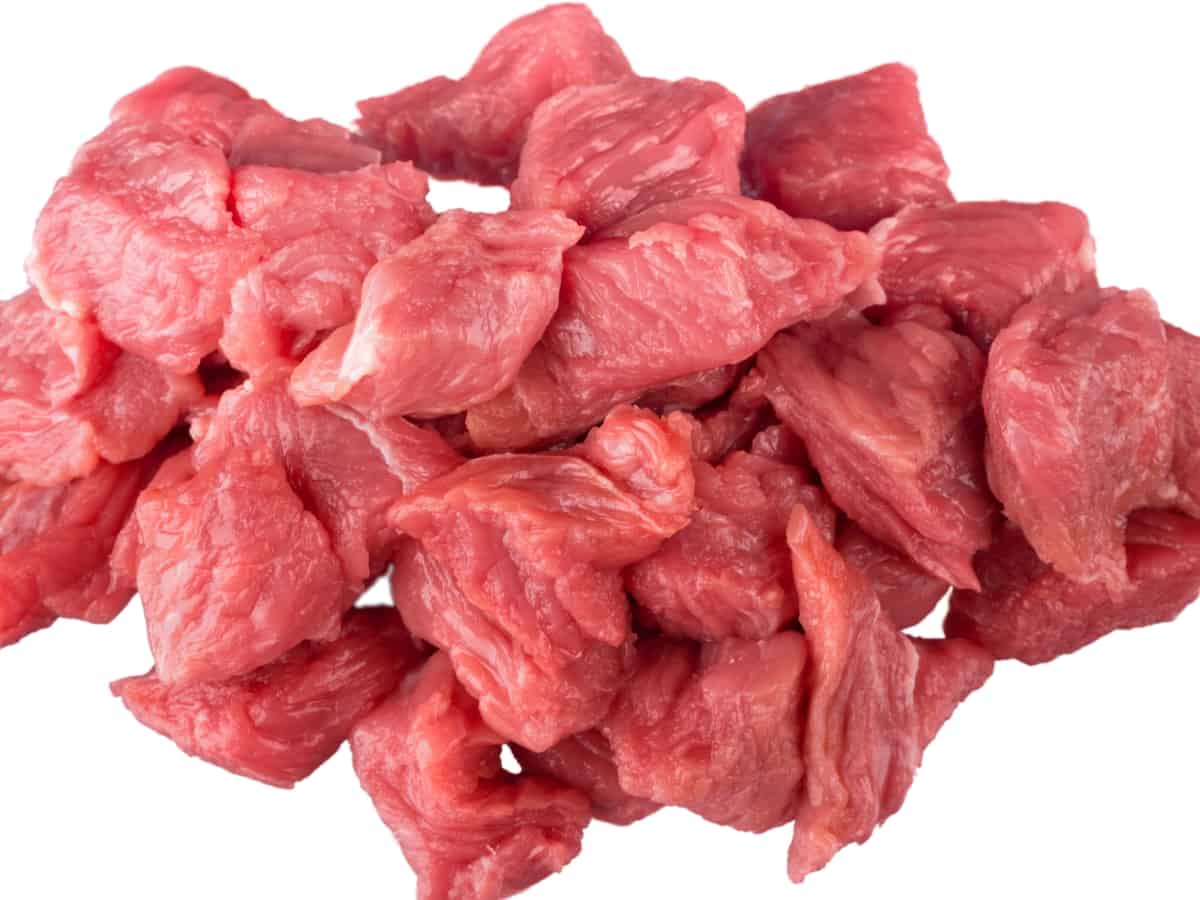
Beef
Beef is an excellent protein source for dogs and is found in many dog foods. It contains various nutrients such as vitamin B6, B12, selenium, zinc, iron, riboflavin, and phosphorus. Beef helps maintain and build muscle mass in dogs and prevents anemia.
Beef and lamb don’t differ as much in their macro nutritional value – they differ in taste and price. You can test to see which of the two your pup prefers. But just like a lamb diet, you’ll need external carbs, primarily from fruit or veggies.
Chicken & Turkey
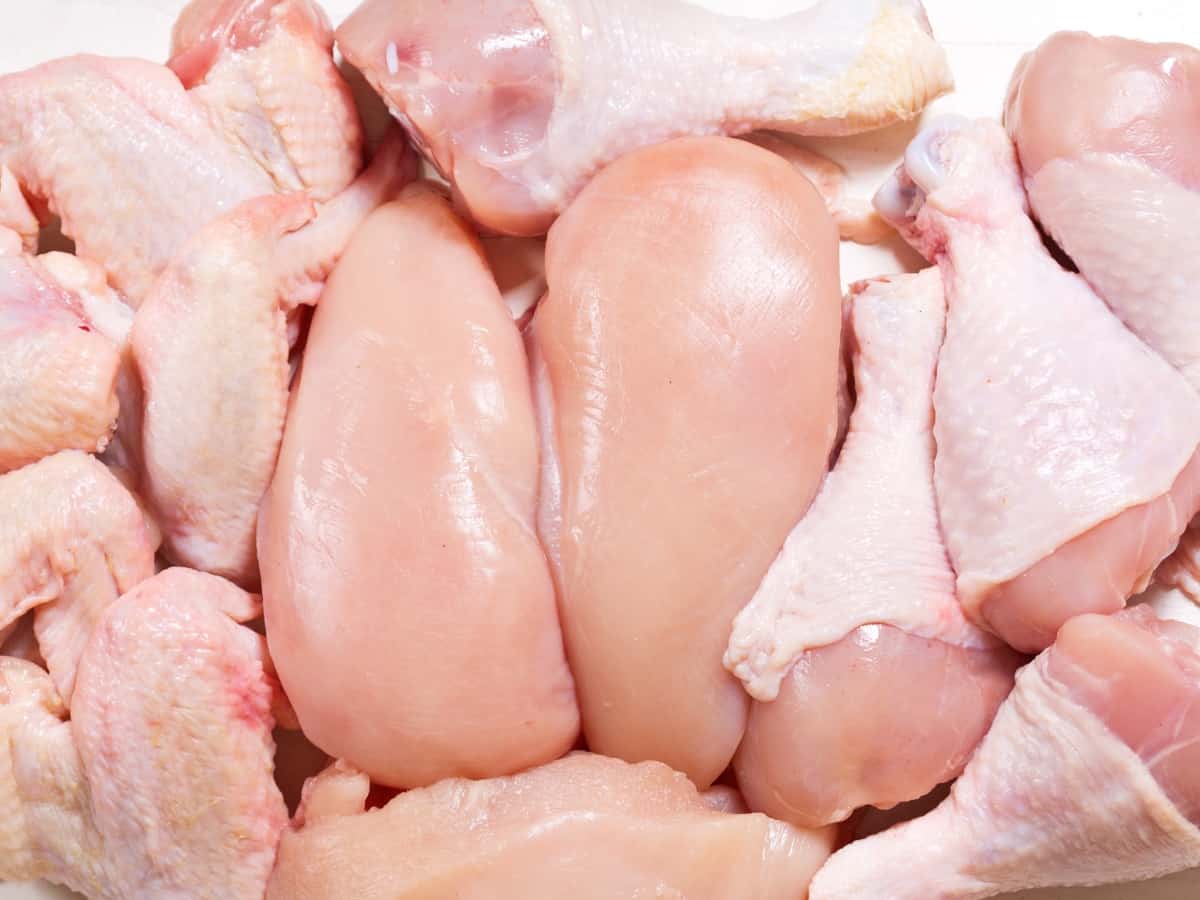
Chicken & Turkey
Large dogs can eat chicken and turkey. They are an excellent protein source providing energy, strong bones and muscles, and contain abundant essential vitamins and minerals. They also have Omega-6 fatty acids, which are good for your dog’s coat and skin.
Chicken and turkey are primary ingredients in commercial dog food and are gentler on your wallet than lamb or beef. But, if you want the best for your dog, avoid chicken meal and by-products.
Fish
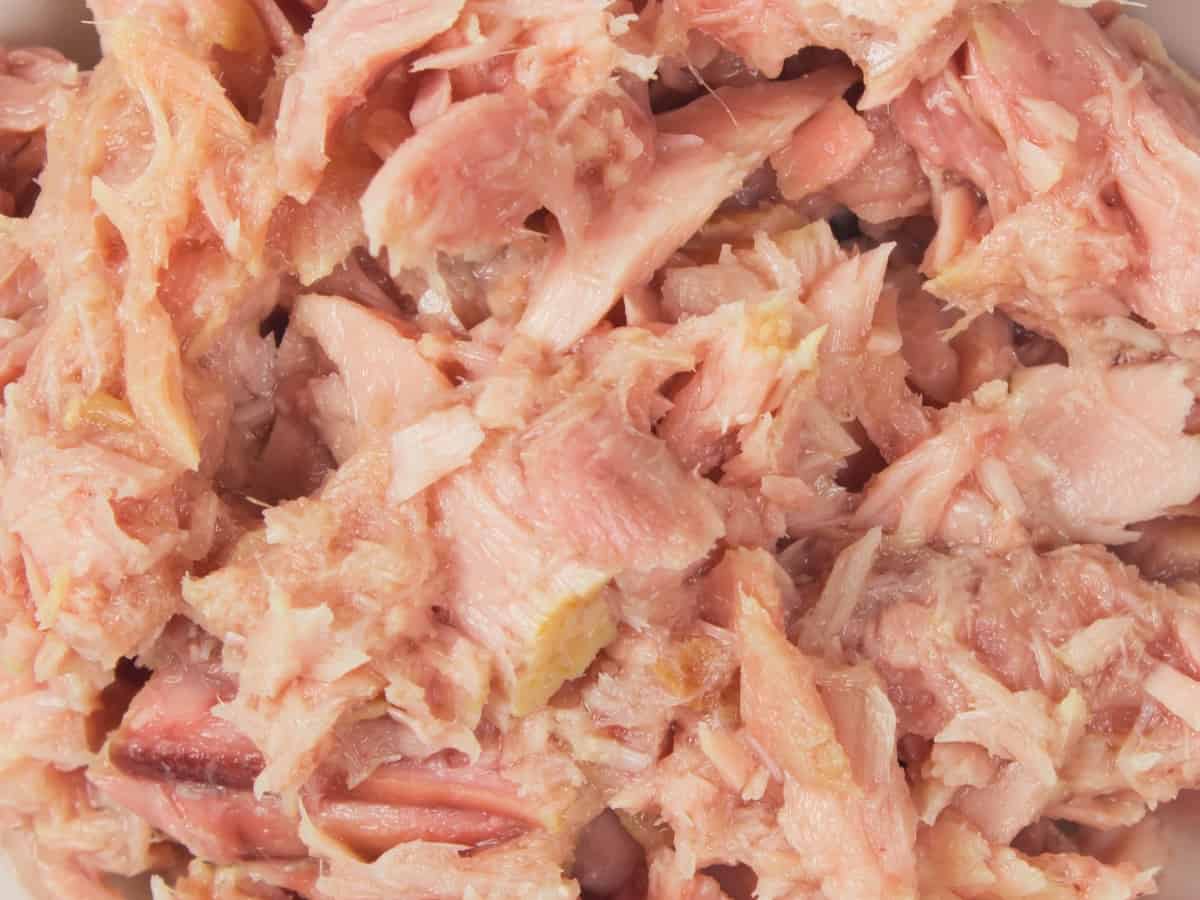
Fish
Fish is typically pretty healthy and often used as an alternate protein source in dog food. Sardines seem to be the lowest-risk fish for a dog as it is a good source of Omega-3. You can also feed your doggo salmon, cod, whitefish, tuna, and mackerel.
Fish can carry parasitic bacteria that are usually killed in the cooking process; hence you should avoid raw fish. Fish bones can be an obstacle, and deboned fish can be expensive. Fish should not be the main protein in your dog’s diet, but it is a great addition. My dog loves a little tuna or salmon topping on her dry food.
Eggs
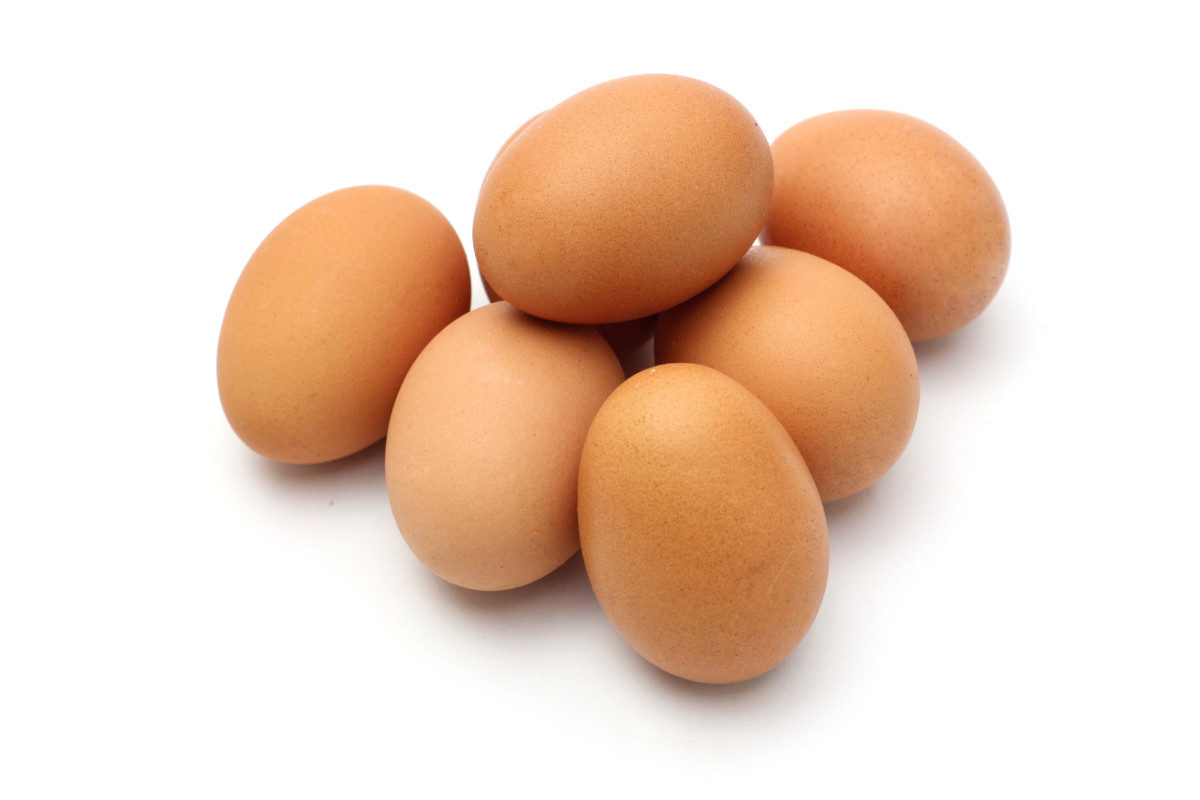
Eggs
Eggs are incredibly nutritious for your dog. They are rich in amino acids – the building blocks of protein. These nutritional powerhouses also contain a wide range of nutrients, including iron, vitamin A, B2, B5, B12, folate, phosphorus, calcium, zinc, selenium, and fatty acids.
You can feed eggs raw but know the risks of salmonella and follow all food safety guidelines. Consult your vet before feeding your dog raw eggs.
Large Dog Diet – Grains
Large-breed dogs can eat grains such as rice, whole wheat, oats, and corn. As omnivores, their digestive system has adapted over thousands of years of canine domestication, and they can thrive on a grain-inclusive diet.
Grains fuel the cells in the body and provide carbs, protein, fiber, vitamins, minerals, essential fatty acids, and antioxidants. Grains support a healthy immune system, skin, and coat.
| Wheat | Corn | Buckwheat |
| Rice | Maize | Barley |
| Oats | Rye | Teff |
| Oatmeal | Quinoa | Amaranth |
| Spelt | Bulgar | Millet |
Some grains are more nutritious than others. For example, whole grains are healthier, so choose brown rice instead of white. The only exception is if your dog has diarrhea, then feed white rice as it binds the stools.
Don’t be sucked into the hype created by some pet food brands that grains cause allergies in dogs and that dogs should eat grain-free.
The reality is that food allergies in dogs are rare, and dogs are more likely to react to protein sources such as beef and dairy.
Large Dog Diet – Fruits
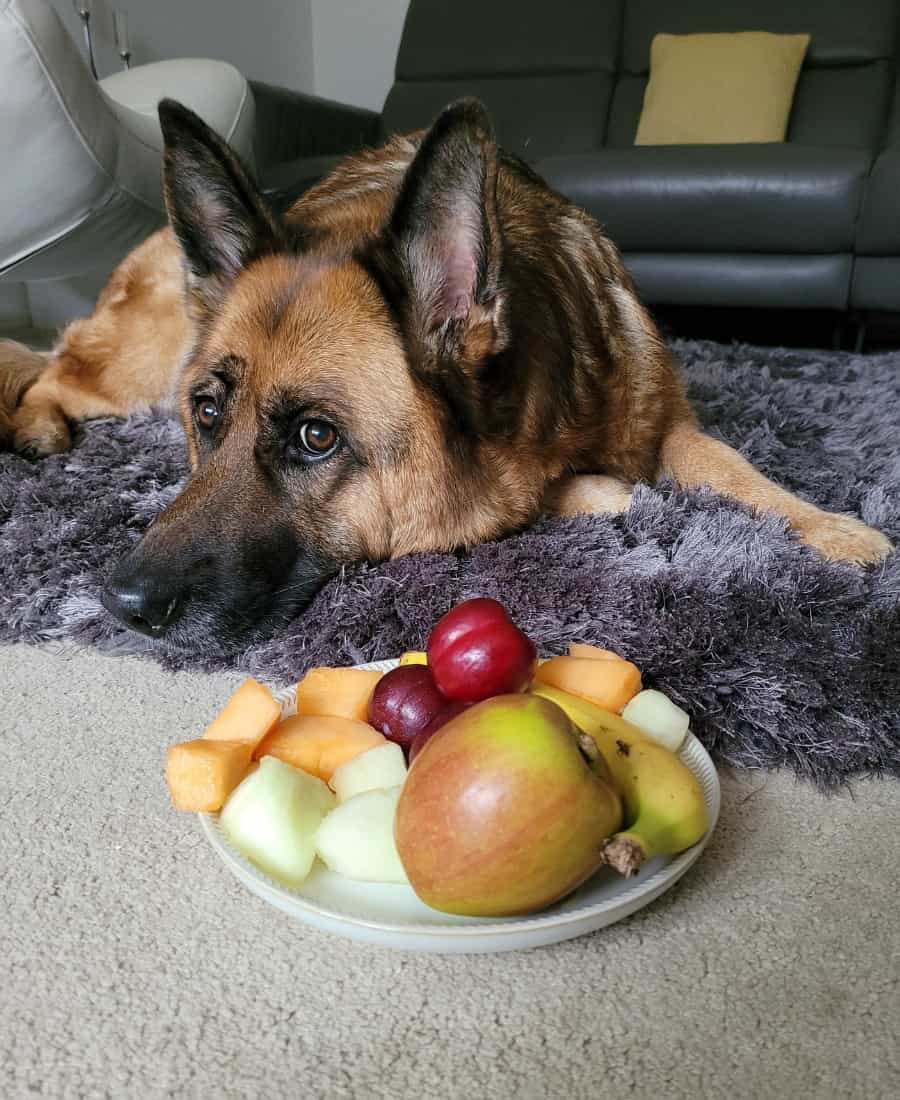
Big dogs can eat fruits such as apples, watermelon, strawberries, bananas, pears, or raspberries, but no matter how vegan you are, please do not make your dog survive on fruits alone.
Since fruits have an average of 2% to 6% protein, they cannot replace the protein in meat.
Fruits should be more of a carb supplement in your dog’s diet. Above all, avoid feeding grapes, raisins, and other dried variants to your dog.
Here is a tabled view of the main fruits that dogs can eat.
| Apple | Apricot | Pineapple |
| Cucumber | Kiwi Fruit | Watermelon |
| Banana | Nectarine | Strawberries |
| Blackberries | Plum | Mango |
| Blueberries | Raspberries | Coconut |
| Pear | Olive | Dates |
| Melon | Peach | Persimmon |
Large Dog Diet – Vegetables
Dogs can eat vegetables such as peas, green beans, carrots, pumpkin, and sweet potatoes. Although they are carb-rich, they have more protein than fruits.
Still, their macronutrient ratio is not enough to offset meat in a dog’s diet, but it can be used as a carb supplement – just like fruits.
You can try the various vegetables in the table below to discover what your doggo loves the most. My dog enjoys chopped carrots, sweet potatoes, and peas as a mix-in to her kibble.
| Broccoli | Cauliflower | Eggplant |
| Asparagus | Artichoke | Parsnips |
| Green Beans | Potato (cooked) | Spinach |
| Corn | Peas | Bell Peppers |
| Brussels Sprouts | Cabbage | Celery |
| Pumpkin | Kale | Lettuce |
| Carrot | Beets | Rutabaga |
| Sweet Potato | Squash | Zucchini |
Large Dog Diet – Dairy
Dairy foods provide protein, fats, and carbs. They are a source of calcium, phosphorus, vitamins A, D, and B12, zinc, potassium, magnesium, and selenium. They are excellent for supporting bone health.
Big dogs can eat some dairy foods in moderation as long as they are not lactose intolerant, meaning that they cannot digest lactose, a sugar found in milk and other dairy products.
Different dairy foods contain varying amounts of lactose. Some lactose-intolerant pooches have trouble digesting milk but can enjoy small amounts of cheese and natural yogurt.
Experimenting with small amounts is best to see what your dog can handle.
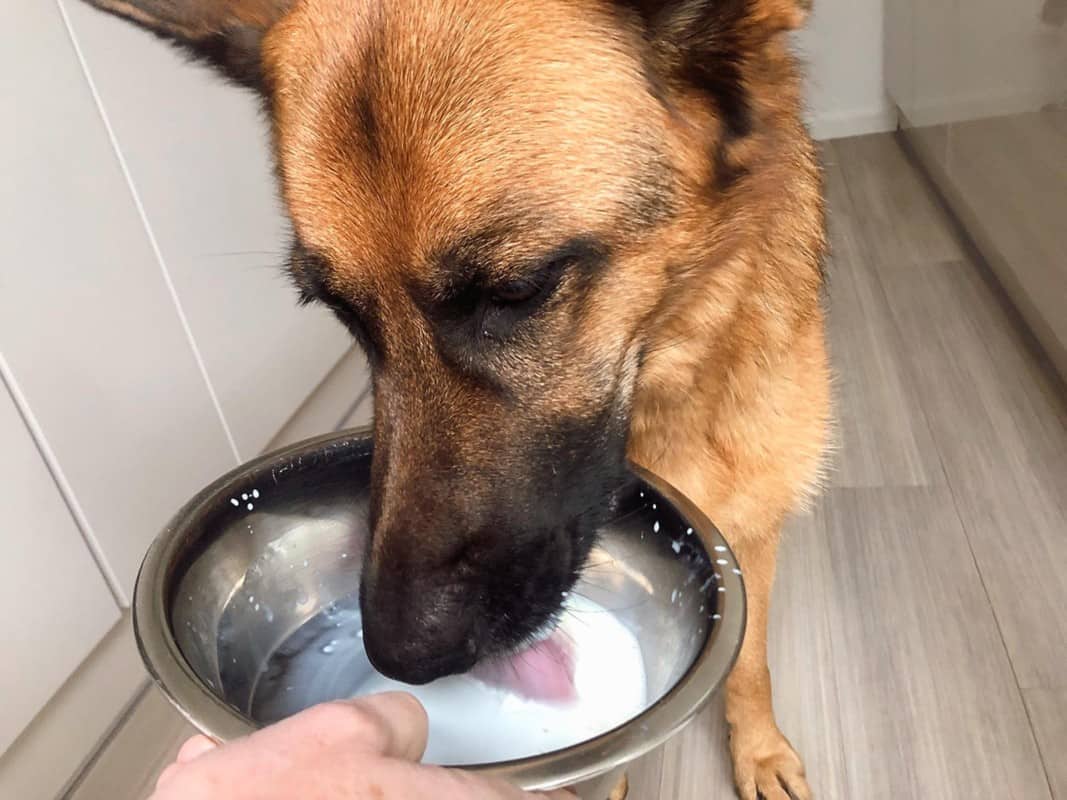
Types of Dog Food – Choosing The Right Diet
Dog food companies have spent millions of dollars researching which ingredients offer the highest quantities of nutrients to provide a healthy, balanced diet that promotes essential large-breed puppy growth and development.
The main types of diet that you can feed your dog are:
- Dry food
- Wet food
- Semi-moist dog food
- Home produced diet
- Raw diet
- Dehydrated
- Freeze-dried
- A mixed diet
In the next section, I’ll delve deeper into these doggy diets.
Dry Dog Food
Dry dog food is preferred by most large and giant breeds while sometimes rejected by others.
Meat, veggies, and grains, with added vitamins and minerals, are formed into small, bite-sized pieces and then baked or extruded to create the final kibble product.
One of the main benefits of dry dog food is its convenience and shelf stability. It does not require refrigeration and can be stored at room temperature for extended periods, making it an easy option if you’re always on the go with your dog.
Dry dog food is also relatively inexpensive compared to other types of pet food, and it can result in less waste because it can be left in your dog’s feeding dish for longer.
Additionally, kibble benefits dogs with dental problems because it helps clean their teeth and gums. Numerous studies have found that kibble can reduce plaque. This study even found that pellet food size prevents calculus accumulation.
However, dry dog food is lower in moisture content than wet or canned dog food, which can be a concern for dogs not drinking enough water. However, you can soften it, and I show you how in this article.
And as some dry dog food brands have been found to contain low-quality ingredients or additives, ensure you choose a high-quality brand.
See also: Is Kibble Bad For Dogs? What No One Is Talking About!
A newer type of dry dog food is COLD PRESSED, which I feed my dog. It is made quickly and at a much lower temperature than kibble, which preserves the nutritional value of the food.
I would describe it as having the nutritional benefits of a raw diet yet with the convenience of dry food.
However, of far more appeal to me is that cold-pressed dog food breaks down quicker in the stomach, helping to reduce the risk of bloat, which is a life-threatening condition to which large and giant breed dogs are prone.
Wet Dog Food
You can try wet dog food if your dog turns his nose up at dry kibble. Some larger dogs like it, whereas others prefer a bit of crunch. Take note, though, that canned wet food can be expensive for big dogs as you will need to provide much more.
Ensure you check the protein content, as wet food contains a lot of water. But canned wet food may suit dogs that don’t drink much water or have dental problems.
You can feed wet dog food alone or as a topper on dry kibble to boost flavor and moisture. This is one thing I like to occasionally do for Willow to change things up for her.
Dry Dog Food vs. Wet Dog Food
As kibble and wet dog foods are the most popular, here’s a handy table comparing the pros and cons of both.
| Dry Dog Food | Wet Dog Food |
|---|---|
| More practicable for large dogs | More practicable for a toy or small breeds |
| Inexpensive and less waste | Costs more than dry foods |
| Provides more nutrients per bite than wet | Good for picky eaters and senior dogs |
| Convenient and easy to feed | Good for hydration |
| No need to refrigerate | There can be more waste if the food is left uneaten |
| Good for “grazers” as it can be left in the bowl longer | Good for dogs who have trouble chewing |
| Can add cooked meats, fish, or veg | It has a longer shelf life than dry |
| Can add water to make a tasty gravy | Dogs can enjoy a larger portion per meal due to the high water content |
| Available in many shapes and sizes | Some dogs find wet more palatable than dry foods |
| Great for interactive feeders | Beware of added salt and sugar in semi-moist |
| It can be good for the teeth | May contribute to gum disease |
Check out my German Shepherd Willow weighing up the pros and cons of dry vs. wet dog food. Look like she’s going to choose the kibble!
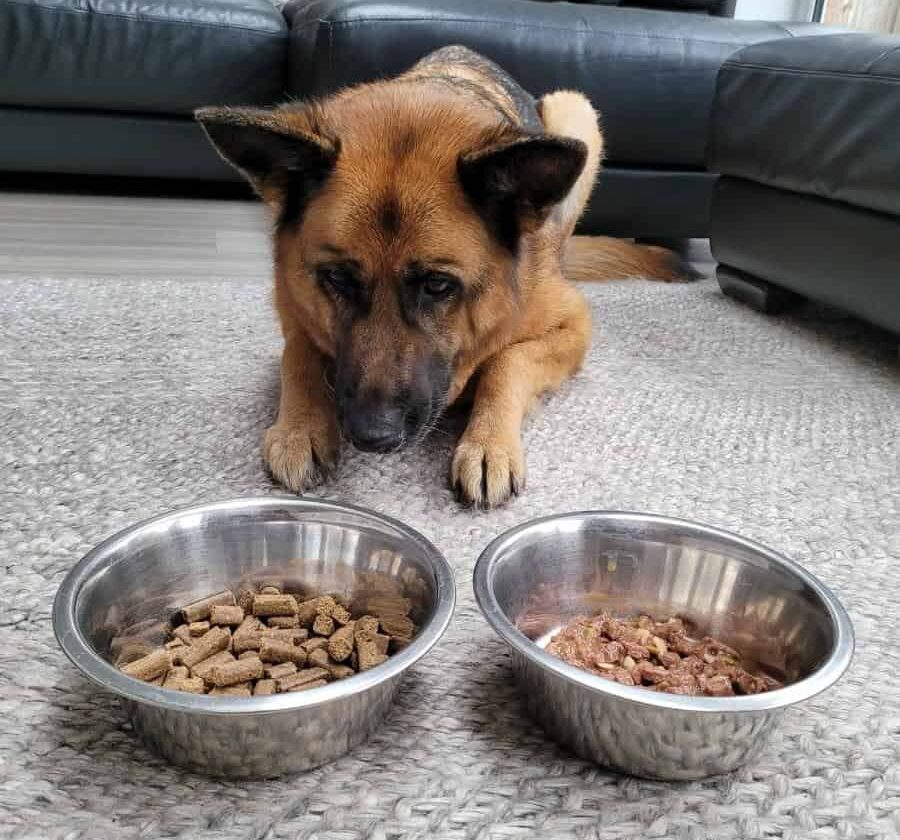
Semi-Moist Dog Food
You may also consider semi-moist dog food. However, this type of doggy diet is not as common as other kinds, as it offers the least nutritional value and is pretty expensive.
Unfortunately, sugar and salts are added by manufacturers to preserve moisture and shelf life. Many semi-moist foods are also loaded with artificial colors, chemical preservatives, and flavor enhancers.
A semi-moist diet may not suit your big dog, especially if he is overweight.
Advocates of this type of diet will say that it is highly palatable, which may suit extremely picky eaters. It is also easy and convenient to feed.
This study of dogs’ taste preferences in a laboratory environment found that canned or semi-moist dog food was preferred to kibble, as was cooked meat to raw.
Learn More About The Various Types of Dog Food In This Video…
Homemade Dog Food
Wet dog food isn’t the exclusive domain of factories. You can use one of countless dog chow recipes to produce homemade dog food.
Some dog owners enjoy home cooking for their furry friends as it gives them complete control of what they feed their dogs.
However, it can also be expensive and very time-consuming. You can read more here: Is It Cheaper To Make Your Own Dog Food?
If you want to be a home feeder, you should consult your veterinarian or a canine nutritionist to check your dog has the proper balance of food groups and isn’t missing out on any vital nutrients.
Check out the American College of Veterinary Nutrition, as they have a helpful directory of certified vet nutritionists.
Raw Dog Food
Of course, if you grasp the concept of feeding chow made from leftover meat, you can always get your bestie a prime Wagyu steak. A raw food diet consists of raw meat, organs, and raw bones.
This method of feeding your dog has grown in popularity over the past decade.
See also: The Cost To Feed Raw Dog Food
You can prepare a raw diet at home, similar to a home-cooked meal, or buy pre-prepared complete and balanced raw food, which is more convenient.
If you choose to prepare a raw diet yourself, remember to check with your vet or a canine nutritionist that you’re providing all the right foods in their correct ratios.
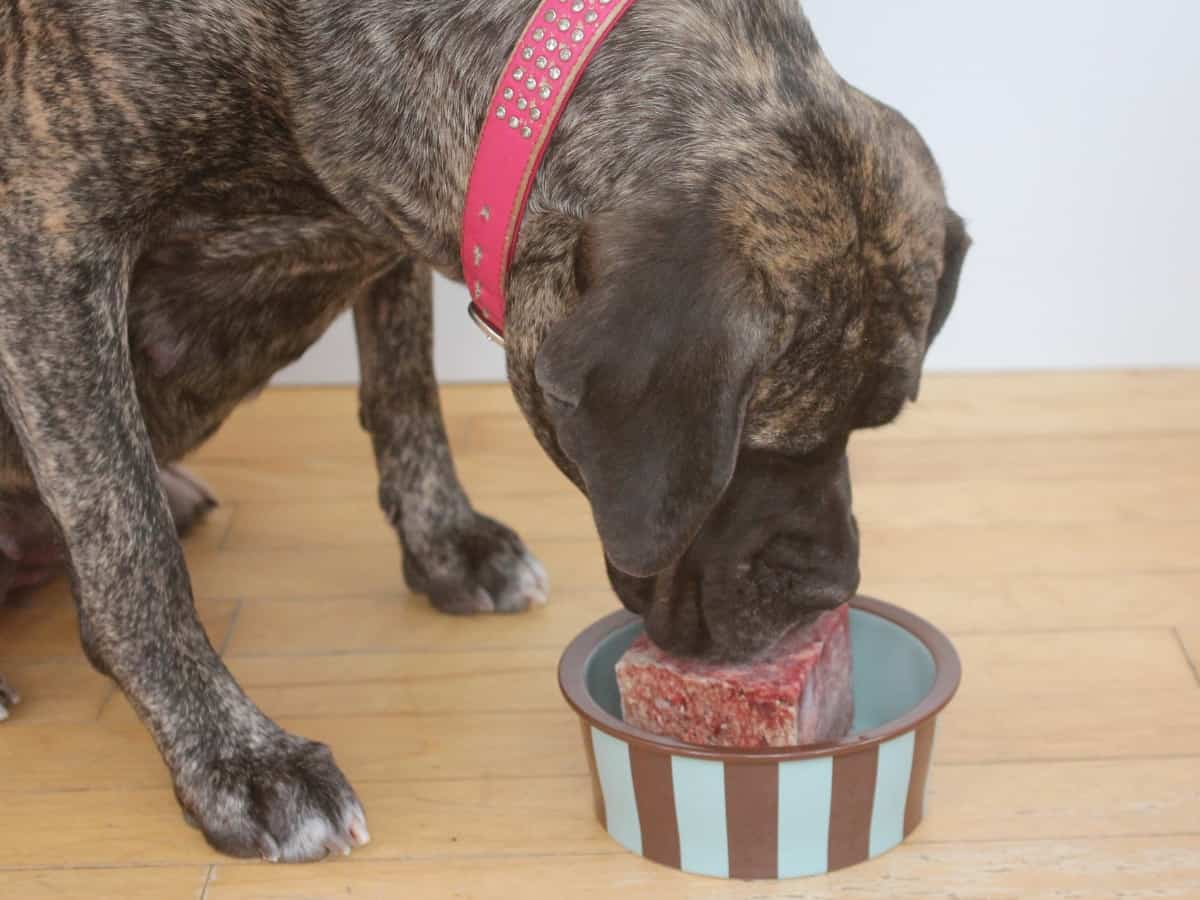
Dehydrated Dog Food
Given that dehydrated dog food (sometimes referred to as air-dried) is technically dry, it is frequently mistaken for dry dog food.
However, you must add water to rehydrate it and get the food into the shape it is intended to be served.
A dehydrated dog diet is a healthy and minimally processed feeding option as it uses low heat to remove moisture and a gentle drying method. It combines the convenience of dry food yet is more nutritious and healthy than kibble.
It is also easier to digest and doesn’t contain artificial preservatives, fillers, and by-products that some low-quality kibble contains, often giving dogs with sensitive stomachs a hard time.
Freeze-Dried Dog Food
Freeze-dried dog food removes moisture from the food in a freeze-dryer at very cold temperatures.
In this way, the nutrients are relatively undamaged, making this diet seemingly the most “organic” form of dry dog food on the market.
When you buy freeze-dried dog food, it is still raw, and it does not have to be rehydrated before it’s eaten. However, rehydrating the food can make it easier to digest.
Since there is no moisture for microbes to live once the food is sealed in packaging, it may take years for the food to decompose. However, it is expensive and out of most owners’ price ranges.
Dry and Wet Mix
This is one of the most widely preferred food types for large dogs, and you get the best of both worlds. It is also my dog’s method of feeding.
Most dogs that dislike dry or wet food will like a wet and dry mix. Adding a few scoops of wet food to dry food changes the texture and palatability of the food, making it enticing to your dog.
If you don’t want to combine the foods in the same bowl, try giving dry food in the morning and wet in the evening or vice versa.
It’s easier to stick to the same brand if choosing a wet and dry mix. However, you can combine dog food brands as long as they have the appropriate nutritional value.
Another alternative is to add a topping to the kibble, such as some chicken, beef, fruit, veggies, cheese, or plain yogurt. This gives your dog variety – but remember to adjust the calories accordingly by reducing the amount of dry food.
Check out the images below of my dog eating:
- A 50/50 mix of dry and wet food
- Kibble with a beef topping
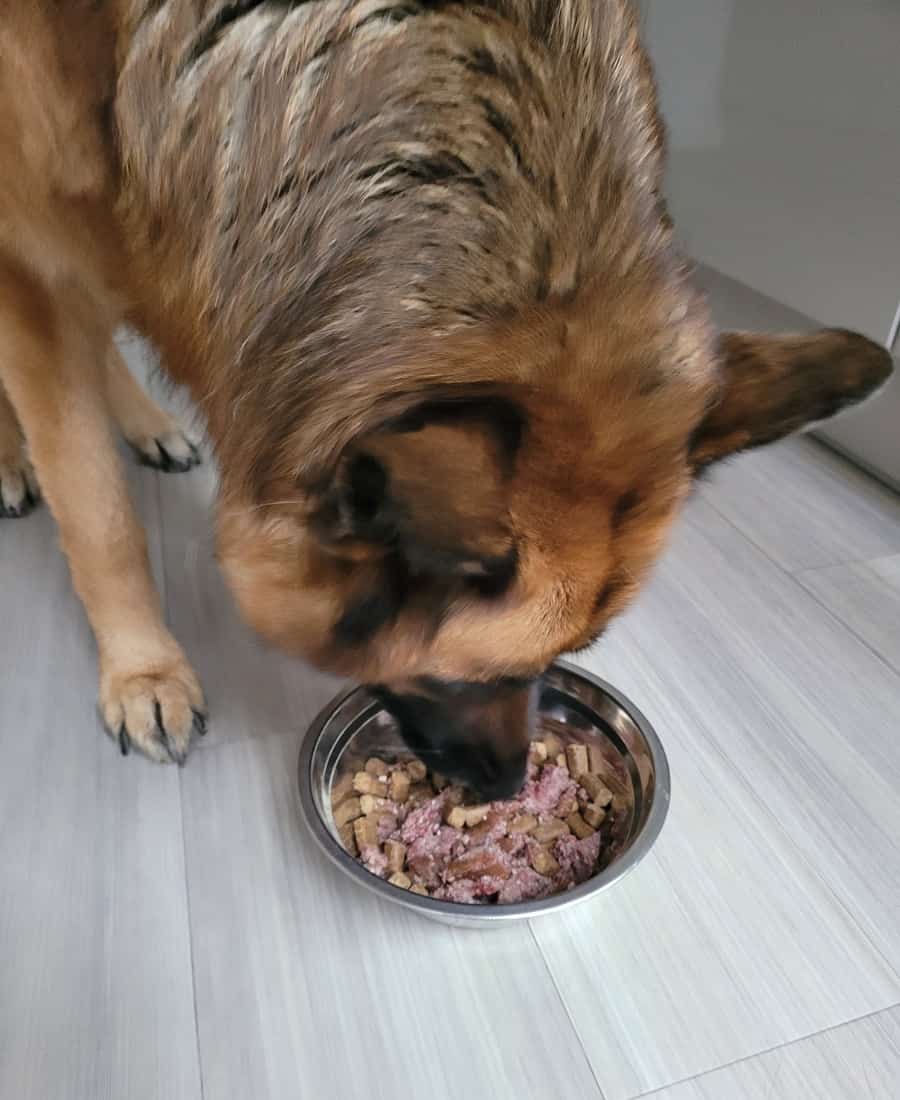
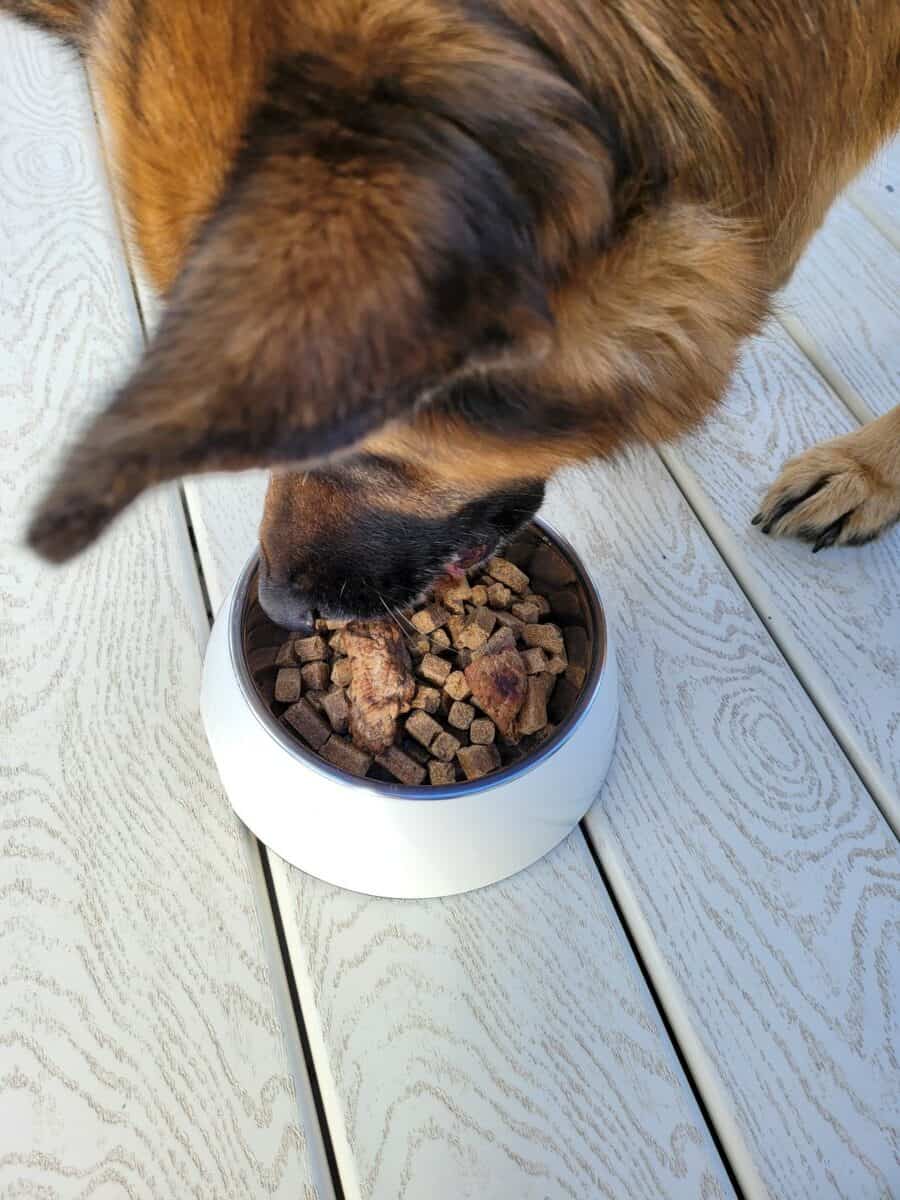
Finally, if you’re considering feeding a mixed diet, here are some pros and cons:
| Pros of a Mix Diet | Cons of a Mix Diet |
|---|---|
| You get the best of both dry and wet | Need to track calorie intake |
| Can mix in the same bowl or at separate feeds | May require your vet’s advice |
| Provides variety | More planning required |
What Is The Best Diet for Large Dogs?
Now you know all the different types of doggy diets, you have to decide on the best type of dog food for your large breed. When faced with too many options, it can be difficult to know where to begin, but it’s really not that difficult.
Let me help!
The best diet for large breed dogs is good quality dry food as it’s convenient, cost-effective, and good for dental health.
However, some big dogs might prefer a wet diet, and if that’s the case, mix the two for a good balance. Large dogs can also try homemade, raw, dehydrated, or freeze-dried diets.
What Foods Can Big Dogs NOT Eat?
There are some foods that big dogs should not eat as they can cause mild stomach upset or prove fatal in severe poisoning cases.
Dogs generally cannot eat onion, garlic, grapes, raisins, chocolate, macadamia nuts, or avocado. Moreover, you should keep alcohol, sugar, and caffeine out of reach.
The table below covers most “must avoid” foods. However, this is not an exhaustive list, so if you are unsure of the toxicity of a product or if your dog just ate something toxic, immediately call your vet or the Pet Poison Helpline.
| Food | Why Your Dog Should Not Eat It |
|---|---|
| Onion | Onion can kill red blood cells in a dog. Even onion powder in a broth can have this effect. |
| Garlic | Garlic can make your dog anemic. Make sure any food you prepare contains no garlic flavor. |
| Chocolate | Theobromine and caffeine in chocolate and chocolate-adjacent products are highly toxic to dogs. |
| Sweeteners | Peanut butter and other products may contain xylitol, which lowers a dog’s blood sugar. Make sure to select organic. |
| Grapes & Raisins | It is yet unknown what causes grape poisoning. Still, enough cases of canine kidney failure following grape ingestion have been documented to keep them on the “must avoid” list. |
| Nuts | Nuts in excess can lead to vomiting and tremors. Macadamia and Black Walnuts are the worst at this. |
| Cooked bones | Cooked bones are a hazard as they can easily splinter and become a choking hazard or cause internal injuries. Raw bones are fair game, though, as long as they’re wider than the muzzle. |
| Raw fish | Raw fish can carry parasites, and big fish often contain too much mercury. Standard market-packed sardines are the safest fish for a dog. |
| Avocado | The avocado skin and leaves can result in episodes of vomiting due to the toxic persin. |
| Alcohol | Keep alcohol out of your dog’s reach because he can’t digest alcohol. As a result, your dog can OD on alcohol. |
| Sugar | Dogs love sweet treats, but if you feed them a sugar-rich diet, they will get fat. If you don’t want your pooch to look like a middle-aged, recently divorced wolf, you should keep sugary treats out of his diet. |
| Yeast Dough | If you bake bread at home, keep your dog away from the unbaked dough as it can ferment in the stomach causing alcohol toxicosis. The yeast can rise in the gut, causing a dangerous blockage. |
| Moldy Food | Avoid letting your dog eat moldy bread or blue cheese, and keep him away from the trash, as mold contains mycotoxins that can be deadly. |
How Much Food Should a Large Dog Eat?
Your large dog’s food needs will largely depend on several factors, including weight, activity level, age, metabolism, and overall health. The key is to ensure you don’t overfeed or underfeed your dog.
As a general guideline, adult large-breed dogs should be fed 2-3 cups of dry kibble daily, or 10g per 1kg of body weight per day, divided into two meals. A starting point for seniors would be 8g per 1kg of body weight.
If you are feeding a commercial diet, follow the recommended feeding instructions on the packaging. Most of the time, these are pretty accurate. However, it’s always best to consult with a veterinarian for specific recommendations for your dog.
Here are some other things to consider:
- Puppies need twice as many calories per pound of body weight as adult dogs.
- Dogs who get minimal exercise may need 10% less than what’s advised on the food label.
- Very active or working breeds may need 20% to 40% more food.
- Adjust your dog’s health or body condition, as serious illness, pregnancy, or breastfeeding can increase energy requirements.
- Working dogs, like hunting or service dogs, may require specialized food with higher fat content to meet their increased energy needs.
You can also use this handy dog calorie calculator, consult your veterinarian, or refer to the National Research Council’s science-based guide for your dog’s nutritional needs.
If feeding a home-cooked or raw diet, a general guideline is to feed them 2-3% of their ideal body weight per day, divided into two meals. As you may expect, depending on the particular ingredients used, this can vary quite a bit.
Pro Tip! Big dogs should eat twice daily as it makes it easier for them to digest the food, control hunger, and prevent bloat (GDV), which can be life-threatening.
Pro Tip! When my puppy was young, I took her to the vet every few weeks to have her weighed and get her overall health checked.
Large Breed Feeding Schedule & Meal Plan
Large breed puppies should be fed four meals a day up to 3 months of age, three meals a day up to 6 months of age, and two meals a day from 6 months to adulthood.
| Age of Puppy | Daily Meals |
| 6 to 12 weeks | 4 |
| 12 to 24 weeks | 3 |
| 24 weeks onwards | 2 |
Remember to avoid feeding your dog immediately before or after a period of high activity to also reduce the risk of bloating. I like to give it at least an hour on either side of a meal to be on the safe side.
Tips for Transitioning Your Large Dog to a New Diet
If you choose to switch your dog’s food, you must do so very gradually to give his stomach time to get used to the new diet and the taste and texture of the new food. Start by gradually mixing the new food with the old food over a period of several days.
| Old Food | New Food | Transitioning Days |
| 75% | 25% | 3 |
| 50% | 50% | 3 |
| 25% | 75% | 3 |
| 0% | 100% |
Check the nutritional value of the new diet, as it may be different from the old one.
Monitor your pup for any signs of digestive upset, such as diarrhea or vomiting, and adjust the diet accordingly.
Finally, ensure your dog gets enough water, as changes in his diet can also affect water intake, especially if transitioning from wet to dry.
Bones and Treats for Big Doggos
What Bones Are Safe For Big Dogs?
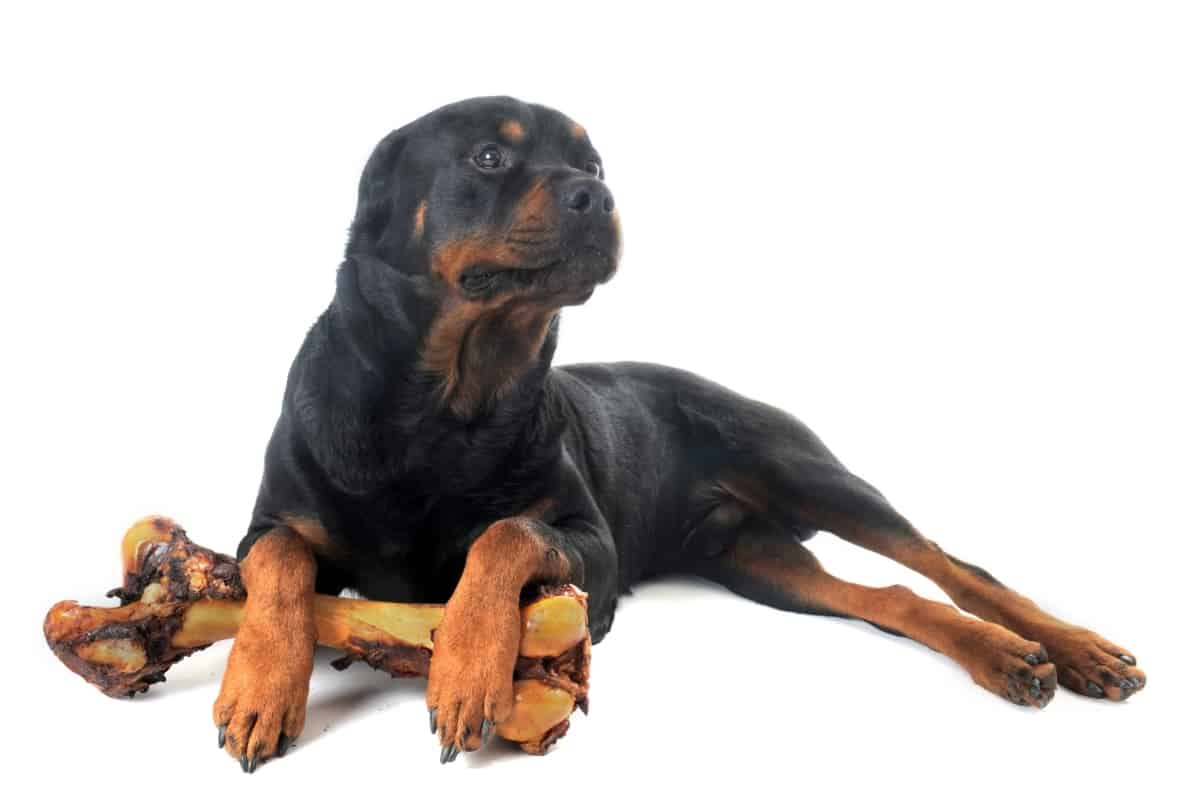
Giving your dog raw bones can give them important nutrients like calcium, magnesium, and phosphorus. Bones also aid in maintaining strong teeth and clean gums.
However, it is important to avoid cooked bones as they can soften and splinter in your dog’s mouth, potentially causing injury or choking.
When selecting a bone, ensure it is larger than your dog’s muzzle to prevent swallowing.
It is also recommended to use stronger bones, such as beef or lamb, instead of chicken or pork to prevent splintering. For instance, a large beef shank bone is suitable for a large breed.
Treats for Large Dogs
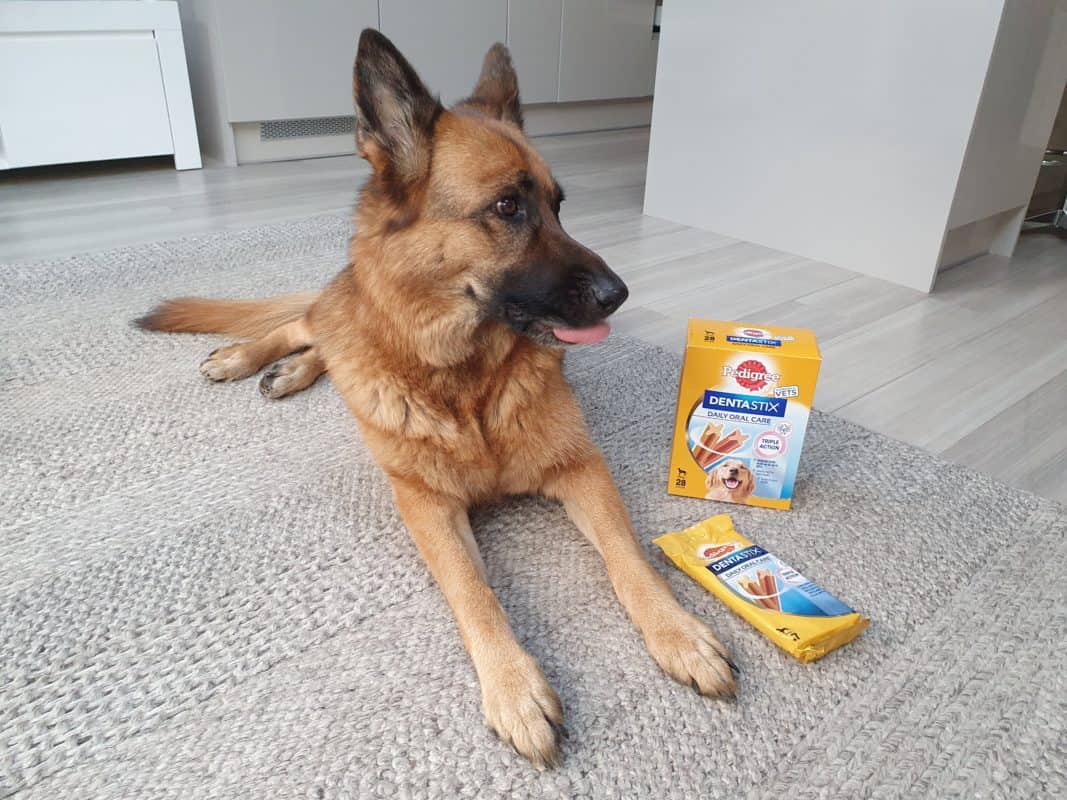
Ensure you buy good quality healthy dog treats, as many treats on the market provide very little nutritional value.
Don’t offer too many treats – the general rule of thumb is to ensure dog treats don’t exceed 10% of your dog’s daily calories. They should be low in fat and calories and free of additives, chemicals, and coloring.
Let’s Wrap This Up!
Good nutrition is essential for proper pet care to maintain your pup’s health and response to disease and injury, so when choosing what to feed your dog, here’s what I recommend:
- Select a diet that fits your dog’s life stage.
- Choose a type of dog food to suit your schedule.
- Invest in high-quality food.





